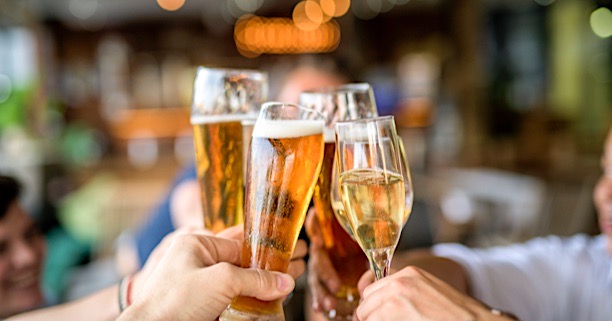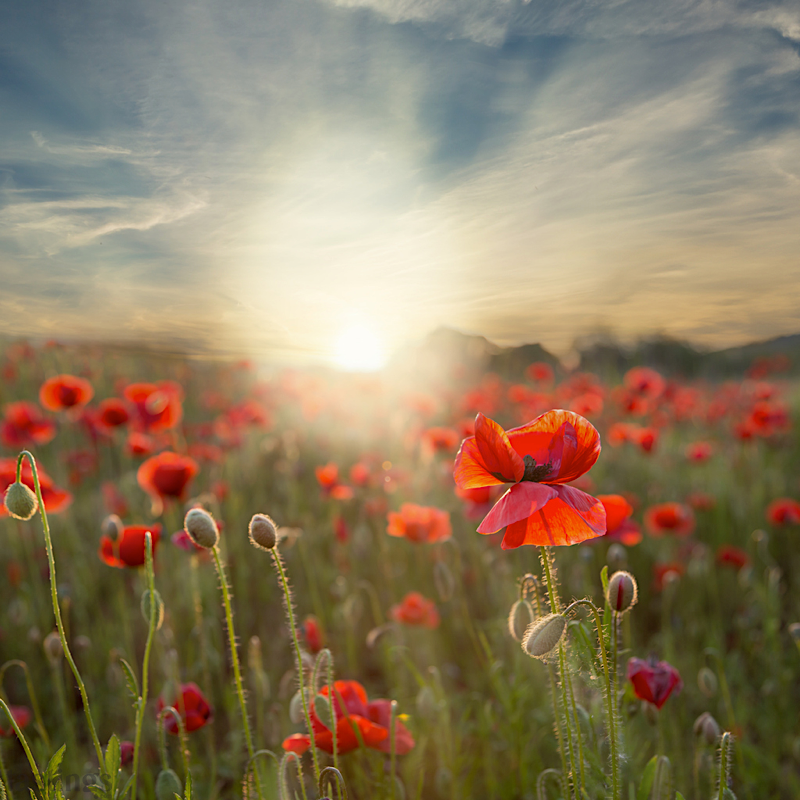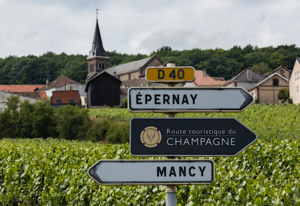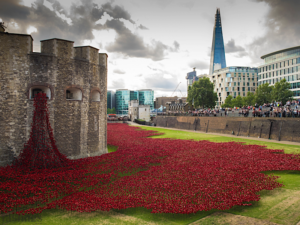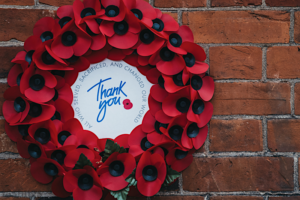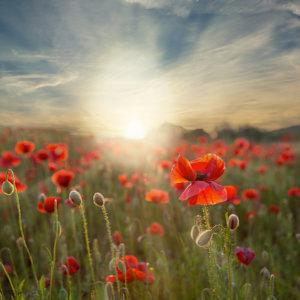Wine has been made in Portugal for more than 4,000 years, and the country’s wines have become widely known for excellent quality and value.
Now there’s an undercurrent of innovation happening in Portugal. Wineries are turning out non-traditional wines that are capturing attention: consider a rosé of Ramisco from the westernmost wine-growing area in all of continental Europe. Or imagine a wine aged in barrels made from Brazilian mahogany or Portuguese eucalyptus or acacia wood.

During a 10-day road trip starting in the Lisboa DO, progressing north to Bairrada, then winding east through the Douro Valley and gliding south to Dão, I encountered some eye-opening winemaking techniques and philosophies that are adding new excitement to Portuguese wines.
We started in the Lisboa DO and specifically, the Colares sub-region, just a few kilometers from the Atlantic Ocean, at Ramilo Wines. Winemaker Jorge Mata practices low-intervention winemaking, using the least amount of sulfites possible, and letting the fruit and the terroir do the talking. “It’s just smashed, fermented grapes,” he says.
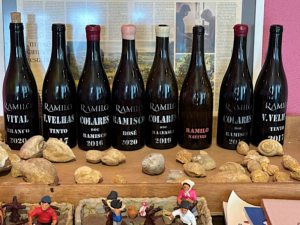
His 2020 Branco (white) of Vidal, Arinto and Malvasia was very floral, very fruity and dry – with a kiss of sea salt (€18). At the other end of the spectrum: Ramilo’s 2022 Rosé of Ramisco with no added sulfites had a nutty aroma – almost Sherry-like – interwoven with salted dried cherries. Ramilo exports 65% of their wines to the U.S. (primarily New York) and Canada through NLC Wines.
Next stop: Prior Lucas Winery in the Bairrada region. Founder and winemaker Rui Lucas welcomed us to “the best wine region in the world,” and explained that the limestone soil, proximity to the Atlantic Ocean and foggy mornings offer ideal conditions for growing the region’s signature Baga and Bical grapes.
Prior Lucas makes two excellent bottle-fermented sparkling wines. The “Falala” sparkling Bical is a Brut Nature that spends 30 months bottle-aging before release. It was beautifully creamy with flavors of apricots and fresh white flowers. His other sparkler, made from the Baga grape is aged for 18 months. He described it as “the rambunctious teenager to Falala’s more sophisticated character.”
Perhaps one of the most unique elements of Prior Lucas are the Fénix line of wines that are aged in barrels hand-made from local woods, like eucalyptus, acacia and chestnut, alongside old barrels made from Brazilian mahogany (Brazil was a Portuguese colony, from the 16th early 19th centuries).
Prior Lucas wines are imported by Nossa Imports in Arizona and Teixeira Wine Group in California.
A few hours’ drive northeast is the famous Douro Valley, the first demarcated wine region in the world (for Port wine) and one of the highest-elevation wine regions in Europe.
While there may be no more traditional Portuguese wine than Port wine, there is innovation happening here. You’ll find canned Port cocktails on every store shelf and menu and a growing number of still wines coming out of the Douro.
During a visit to Quinta do Bomfim (part of the Symington family’s Portuguese wine empire in Pinhão), I learned that today, 80% of wines produced at Bomfim are Port. Just five years ago, Port wines were 95% of total production. Vale de Bomfim’s DOC Douro Red and White still wines (both blends, as most Portuguese wines are) are priced at a friendly $15 and widely available in the U.S. Premium Port Wines is the importer for Dow and Bomfim.
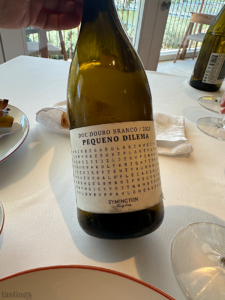
In the Port category, white and rosé Port production is growing to meet consumers’ thirst for Porto Tonico cocktails and Port Spritzes.
A two-hour drive through high, winding roads leads to the Dão region, which is the first demarcated wine region in the world for still wines (in 1908). Casa da Passarella has a unique approach to marketing its wines: the stories come first.

The first story we heard was one of the most touching: that the estate is now owned by Ricardo Cabral, whose grandfather worked in the vineyards decades ago. Cabral purchased it to honor his grandfather and today the estate is thriving, with a new B and B slated to open in the fall for overnight accommodations.
Casa da Passarella has 125 years of stories. “The Fugitive” line of wines is named for a winemaker from France who was on the run back in the 19th century and wound up in Portugal. These wines are the whim of the enologist, Paulo Nunes, who gets to make whatever he wants under this label. Wines under this label are only made in years where the fruit is deemed perfect.
Another story led to the Descoberta line of wines (the word means discovery in Portuguese). In 2010 a box was found inside the walls of Casa Passarella, containing instructions — dated 1942 — to open the box in 50 years, and distribute the contents to the poor. While there was nothing inside the box, after a professor who specialized in “unusual events,” declared the box full – it became clear that the box was full of intangibles – like the happiness that wine can create by bringing people together. The wines are excellent and they are imported by M Imports, LLC.
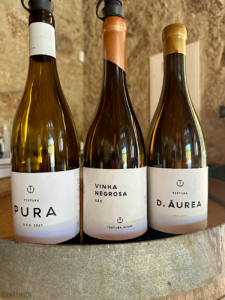
Textura is a new winery in Dāo, founded in 2018 by a Brazilian couple. They farm organically, and offer a range of excellent still wines. Especially interesting was their focus on the Jaen grape – aka Mencia in Spain – including a 100% Jaen wine (Textura da Estella), that was a veritable strawberry field in a glass, accented by roasted meat, fresh and dried herbs ad a bright, saline finish. Textura wines are imported by Grand Cru Selections.
The final stop: Quinta do Sāo Francisco near the town of Viseu is an 18th century farm and winery now run by Sónia Marques and José Nunes. They are still using the lagares – the stone vessels where grapes are food-trodden before fermentation – that date back to the early 1700s. With 8 hectares under vine, Sonia and José specialize in “elastic varieties – grapes that can thrive almost anywhere, like Touriga Nacional, Arinto, Encruzado and Alfrocheiro. They embrace innovation, and as José says, “If you want to have a different experience, go to the small wineries – that is where the innovation and experimentation is happening.”
After tasting a range of Quinta de São Francisco white wines, I can see what he means. A field blend of Malvasia Fina and Encruzado was like a basket of ripe peaches having a happy run-in with some lime zest. The 100% Malvasia Fina was very floral, very botanical (a pine or juniper note snuck into the party), with great structure and acidity. This is the new wine for sushi and other savory Asian specialties. And the Vinhas Velhas (“old vine”) white featured 13 grapes, some from 80+-year old vines. This wine is in four Michelin starred restaurants including The Yeatman in Porto. (No U.S. importer. Yet.)
Next time you are perusing a wine list, a retail shelf of an importer’s or distributor’s portfolio, look for the Portuguese wines that might not be familiar, but might well be delicious and memorable.

